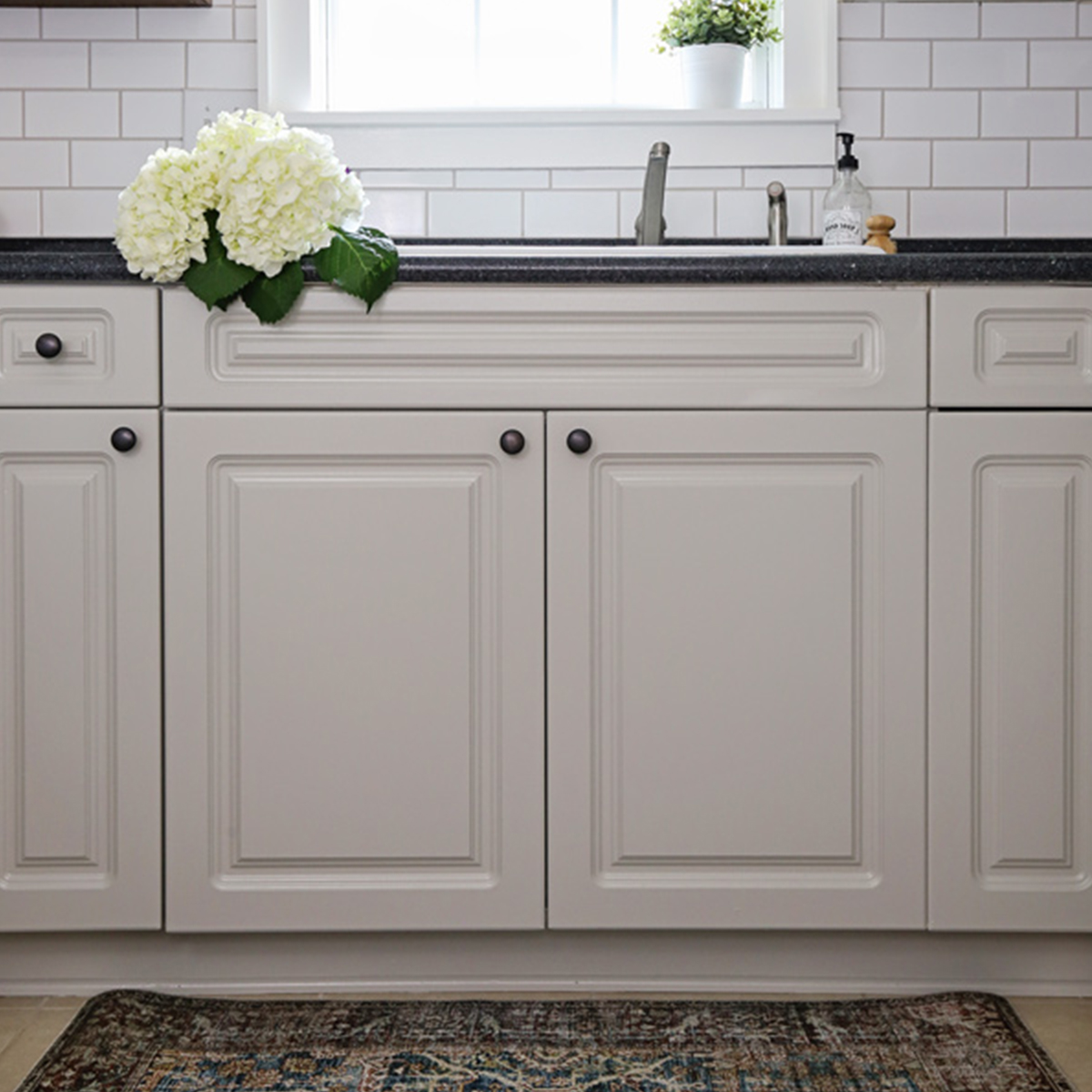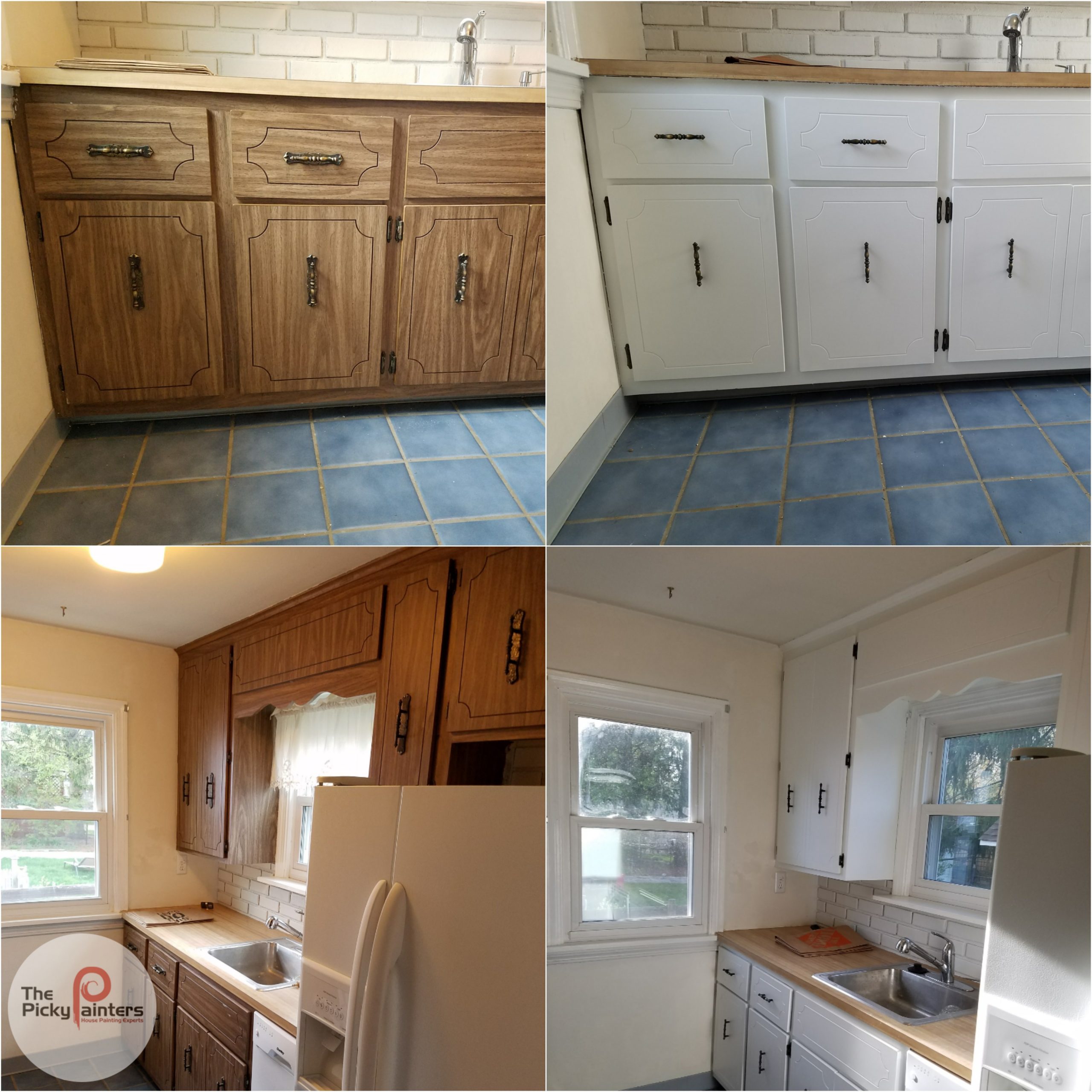Preparing the Cabinets: How To Paint Wood Laminate Kitchen Cabinets

You’ve made the decision to refresh your kitchen cabinets with a new coat of paint, and you’re ready to get started. Before you grab your paintbrush, it’s crucial to properly prepare your laminate cabinets. This ensures a smooth, long-lasting finish that you’ll love for years to come.
Cleaning Laminate Cabinets
Cleaning your cabinets thoroughly is the first step in prepping them for painting. Laminate surfaces can accumulate grease, dirt, and grime over time, which can interfere with the paint’s adhesion.
- Start by wiping down your cabinets with a damp cloth and a mild dish soap. Pay close attention to areas that tend to collect grime, such as handles, doors, and around the sink.
- After cleaning, rinse the cabinets thoroughly with clean water and allow them to dry completely. You can use a soft cloth to dry them or let them air dry.
Sanding Laminate Cabinets
Sanding is essential for creating a surface that paint can adhere to. Laminate is a smooth, non-porous surface, and sanding helps to create a rough texture that paint can grip onto.
- Use fine-grit sandpaper (180-220 grit) to lightly sand the entire surface of your cabinets. Focus on sanding any imperfections, such as scratches or bumps, to create a smooth and even surface.
- Remember to sand with the grain of the laminate. Sanding against the grain can create scratches that will be visible in the final paint finish.
- After sanding, wipe down the cabinets with a tack cloth to remove any dust or debris. This will ensure that your paint adheres properly.
Priming Laminate Cabinets
Using a primer specifically designed for laminate surfaces is crucial for achieving a durable and long-lasting finish.
- Primer acts as a bonding agent between the laminate surface and the paint. It helps to prevent the paint from peeling or chipping, and it also provides a smooth, even base for the paint to adhere to.
- Choose a primer that is specifically formulated for laminate surfaces. These primers are designed to create a strong bond with the smooth, non-porous surface of laminate.
- Apply the primer using a brush or roller, following the manufacturer’s instructions. Ensure that the primer is applied evenly and thinly to avoid drips or runs. Allow the primer to dry completely before applying the paint.
Using a Deglosser
A deglosser is a liquid solution that helps to remove the shine from glossy surfaces, such as laminate cabinets.
- Using a deglosser is important because it creates a more textured surface for the paint to adhere to. This will help to prevent the paint from peeling or chipping over time.
- Apply the deglosser according to the manufacturer’s instructions. Typically, you’ll need to apply it with a brush or roller, and then allow it to dry completely before sanding the surface.
- After applying the deglosser, sand the surface lightly with fine-grit sandpaper (180-220 grit). This will help to create a smooth, even surface for the paint to adhere to.
Choosing the Right Paint

Selecting the right paint is crucial for a successful laminate cabinet makeover. The type of paint you choose will directly impact the durability, finish, and overall look of your cabinets.
Types of Paint for Laminate Cabinets
The choice between latex, oil-based, and specialty paints depends on your specific needs and preferences.
- Latex Paint: This is a popular choice for many DIY projects, including painting laminate cabinets. Latex paint is water-based, making it easy to clean up with soap and water. It dries quickly and emits low VOCs, making it a more environmentally friendly option. However, latex paint may not be as durable as oil-based paint, especially in high-traffic areas.
- Oil-Based Paint: Oil-based paint is known for its durability and resistance to moisture, making it a good choice for kitchen cabinets. It offers a smoother finish and better adhesion to slick surfaces like laminate. However, oil-based paint takes longer to dry, emits strong odors, and requires mineral spirits for cleanup.
- Specialty Paints: Specialty paints, such as bonding primers and epoxy paints, are designed specifically for laminate surfaces. These paints provide excellent adhesion and durability, making them a great option for high-wear areas. However, they can be more expensive than traditional latex or oil-based paints.
Choosing the Right Sheen
The sheen of your paint will affect the look and durability of your cabinets.
- Matte: Matte paint has a flat, non-reflective finish, which can help to hide imperfections. However, matte paint is more susceptible to stains and scratches.
- Eggshell: Eggshell paint has a slightly glossy finish, offering a balance between durability and a soft, subtle look. It is a good choice for kitchen cabinets as it is more stain-resistant than matte paint.
- Satin: Satin paint has a smooth, low-sheen finish that is durable and easy to clean. It is a popular choice for kitchen cabinets as it offers a balance between durability and a soft, elegant look.
- Semi-Gloss: Semi-gloss paint has a noticeable shine and is very durable and easy to clean. It is a good choice for high-traffic areas, such as kitchen cabinets, but it may highlight imperfections.
- Gloss: Gloss paint has a high shine and is the most durable and easy to clean. However, it can be too shiny for some people and may highlight imperfections.
Importance of High-Quality Paint
Choosing a high-quality paint is essential for a long-lasting finish.
Investing in a good quality paint will ensure that your cabinets look great for years to come.
- Durability: High-quality paint is more resistant to scratches, stains, and fading, ensuring that your cabinets stay looking their best for longer.
- Adhesion: High-quality paint adheres better to laminate surfaces, preventing peeling and chipping.
- Coverage: High-quality paint offers better coverage, requiring fewer coats to achieve a smooth, even finish.
- Ease of Application: High-quality paint is easier to apply, resulting in a smoother, more professional-looking finish.
Selecting the Right Color, How to paint wood laminate kitchen cabinets
Choosing the right color for your laminate cabinets is a personal decision, but it is important to consider your existing decor and personal preferences.
- Existing Decor: Consider the overall color scheme of your kitchen and the colors of your countertops, backsplash, and appliances. Choose a color that complements these elements.
- Personal Preferences: Choose a color that you love and that will make you happy every time you walk into your kitchen. Don’t be afraid to experiment with different colors and finishes.
- Light: Consider the amount of natural light in your kitchen. Lighter colors will reflect more light, making the space feel brighter and larger. Darker colors can create a more intimate and cozy atmosphere.
Painting Techniques

Painting laminate cabinets requires a slightly different approach than painting traditional wood cabinets. The smooth, non-porous surface of laminate can make it challenging for paint to adhere properly. However, with the right techniques and preparation, you can achieve a beautiful and durable finish.
Essential Painting Tools and Materials
Having the right tools and materials is crucial for a successful paint job. Here’s a list of essential items:
- Paintbrushes: Choose high-quality brushes with synthetic bristles, suitable for both latex and oil-based paints. These brushes are designed to apply paint smoothly and evenly on laminate surfaces.
- Paint Roller: A 9-inch roller with a nap length of 1/4 inch is ideal for covering large areas quickly. Choose a roller cover made of high-quality materials that won’t shed fibers.
- Paint Tray and Liner: A paint tray with a liner is essential for loading the roller and keeping your workspace clean.
- Sandpaper: Use fine-grit sandpaper (220-grit) for sanding the laminate surface to create a better grip for the paint.
- Primer: A bonding primer specifically designed for laminate surfaces is essential for creating a strong adhesion base for the paint.
- Paint: Choose a high-quality, durable paint designed for kitchen cabinets. Latex paint is a popular choice for its low odor and easy cleanup.
- Painter’s Tape: Use painter’s tape to protect areas you don’t want to paint, such as countertops, walls, and hardware.
- Drop Cloth: Protect your floors and surrounding areas from paint spills with a drop cloth.
- Cleaning Supplies: Keep cleaning supplies like rags, soap, and water handy for cleaning up spills and messes.
Paint Application Methods
Choosing the right paint application method can significantly impact the final finish. Here’s a table comparing different methods:
| Method | Pros | Cons |
|---|---|---|
| Brushes | Provides precise control, ideal for detail work, good for corners and edges. | Can leave brush strokes, time-consuming for large areas. |
| Rollers | Fast coverage for large areas, smooth finish, good for flat surfaces. | Can leave roller marks, not ideal for intricate details. |
| Sprayers | Fastest application, smooth and even finish, ideal for large areas. | Requires more preparation, potential for overspray, requires proper ventilation. |
Step-by-Step Guide to Painting Laminate Cabinets
Here’s a step-by-step guide on how to paint laminate cabinets:
- Prepare the Cabinets: Clean the cabinets thoroughly with a degreaser and allow them to dry completely. Remove all hardware, including hinges, knobs, and pulls.
- Sand the Surface: Lightly sand the laminate surface with fine-grit sandpaper (220-grit) to create a rough texture for the primer to adhere to.
- Apply Primer: Use a bonding primer specifically designed for laminate surfaces. Apply the primer evenly with a brush or roller, ensuring full coverage. Allow the primer to dry completely according to the manufacturer’s instructions.
- Apply Paint: Apply the first coat of paint with a brush or roller. Use thin coats and allow each coat to dry completely before applying the next. Two to three coats of paint are usually sufficient for full coverage.
- Allow to Dry: Let the paint dry completely before handling the cabinets. The drying time will vary depending on the type of paint used.
- Apply Top Coat: Apply a top coat of clear polyurethane varnish to protect the paint and provide a durable finish. Allow the varnish to dry completely before reattaching the hardware.
Achieving a Smooth and Even Finish
Here are some tips for achieving a smooth and even finish on laminate surfaces:
- Use High-Quality Paint and Primer: Choose a paint and primer specifically designed for laminate surfaces to ensure good adhesion.
- Thin the Paint: If using a brush or roller, thin the paint slightly with water or paint thinner, depending on the type of paint, to improve flow and prevent brush strokes.
- Use Long, Even Strokes: When using a brush, apply paint in long, even strokes, avoiding overlapping strokes to minimize brush marks.
- Avoid Overloading the Roller: Don’t overload the roller with paint. Dip the roller only halfway into the paint tray and roll it off on the liner to remove excess paint.
- Sand Between Coats: Lightly sand between coats with fine-grit sandpaper to smooth out any imperfections and create a smoother finish.
How to paint wood laminate kitchen cabinets – Painting wood laminate kitchen cabinets can be a daunting task, but with the right prep work and technique, you can achieve a stunning transformation. Remember, just like creating the illusion of space in a small bedroom by using light colors and strategically placed mirrors, tips to make a small bedroom look bigger can also apply to your kitchen.
Choose light, bright colors for your cabinets to make the space feel more open and inviting. With a little planning and effort, you can create a kitchen that’s both beautiful and functional.
Painting wood laminate kitchen cabinets can be a fantastic way to refresh your space, but don’t forget about the insides! Upgrading your storage game with wood sliding cabinet shelves will make your kitchen more functional and stylish. Once you’ve given your cabinets a fresh coat of paint, you’ll have a beautiful and organized space to showcase your culinary skills.
